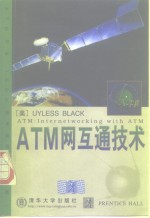
- 作 者:(美)(U.布莱克)Uyless Black著
- 出 版 社:北京:清华大学出版社
- 出版年份:1998
- ISBN:7302028214
- 标注页数:236 页
- PDF页数:251 页
请阅读订购服务说明与试读!
订购服务说明
1、本站所有的书默认都是PDF格式,该格式图书只能阅读和打印,不能再次编辑。
2、除分上下册或者多册的情况下,一般PDF页数一定要大于标注页数才建议下单购买。【本资源251 ≥236页】
图书下载及付费说明
1、所有的电子图书为PDF格式,支持电脑、手机、平板等各类电子设备阅读;可以任意拷贝文件到不同的阅读设备里进行阅读。
2、电子图书在提交订单后一般半小时内处理完成,最晚48小时内处理完成。(非工作日购买会延迟)
3、所有的电子图书都是原书直接扫描方式制作而成。
CHAPTER 1 IntroductionReasons for Internetworking 1
Reasons for Internetworking with ATM 1
Terms and Definitions 2
Internetworking and Interworking 2
L_2 and L_3 Protocol Data Units(PDUs) 3
Addresses and Virtual Circuit Identifiers 3
Routing and Switching 4
Specific Terms for the Virtual Circuit ID 4
Correlating Addresses and Virtual Circuit IDs 4
ATM Internetworking Examples 4
The ATM and Frame Relay Headers 6
Comparison of ATM and Frame Relay 6
Comparison of ATM and LAN Technologies 9
Comparison of ATM and IP 9
Conventions for ATM Interfaces and Data Units 11
Summary 13
CHAPTER 2 Encapsulation and Address Mapping Operations 14
Encapsulation Concepts 14
Service Access Points (SAPS) 16
LLC and LSAPS 17
Ethertype(Type) 18
Subnetwork Access Protocol(SNAP) 18
ISO/IEC TR 9577 (Network Level ProtocolIdentifier[NLPID]) 19
Examples of Joint Use of NLPID and SNAP 20
IP Protocol ID 21
Ports/PSAPS 21
Putting It All Together 22
Example of Encapsulation Operations 24
Support for Layer 2 and 3 Protocols 26
Encapsulation Rules for Frame Relay(RFC 1490) 28
Encapsulation Rules for ATM(RFC 1483) 29
Options in RFC 1483 30
The Address Resolution Protocol(ARP) 31
The ARP Protocol Data Units(PDUs) 33
Frame Relay ARP 34
Classical IP and ARP Over ATM(RFC 1577) 36
The LIS Configuration 37
Rules for Address Resolution 38
Operations at the ATMARP Server and Client 40
Operations at the Server 40
Operations at the ATMARP Client Site 41
ATMARP and Inverse ATMARP Packet Formats 44
ATMARP and INATMARP Packet Encapsulation 44
Multicast Address Resolution Server(MARS) 46
Pros and Cons of MARS 48
Summary 48
ATM/Frame Relay Interworking Models 49
CHAPTER 3 ATM/Frame Relay Interworking Operations 49
Internetworking Definitions 50
Protocol Encapsulation and Protocol Mapping 50
Network and Service Interworking 51
Guides for the User Intefface 51
Primitive Operations 52
Parameter Primitives 54
One Scenario for ATM Frame Relay Interworking 55
Guidance from RFC 1483 56
Summary 58
Why DXI and FUNI were Developed 59
CHAPTER 4 DXI and FUNI 59
DXI and FUNI Topologies 60
A Look at the Headers 61
DXI Modes 62
Example of Modes 1A and 1B 62
Examples of DXI Frames 65
DXI Frame Address Mappings 67
Comparisons of DXI and FUNI 67
Frame Relay vs.DXI/FUNI 67
Summary 69
CHAPTER 5 Network Interworking 70
Network Interworking Concepts 70
Network Interworking Scenarios 71
Network Interworking Functions 74
Variable Length PDU Formatting and Delimiting 76
Error Detection 76
Connection Multiplexing 76
Discard Eligibility and Cell Loss Mapping 79
Congestion Indication 82
PVC Status Management 84
Summary 84
CHAPTER 6 Service Interworking 87
Definitions of Service Interworking 87
FR-ATM Interworking Service 89
Service Interworking Functions 90
Frame Formatting and Delimiting 92
Discard Eligibility and Cell Loss Priority Mapping 93
Congestion Indication 93
Mapping the DLCI 94
PVC Management Procedures 94
Formatting and Identification Procedures 94
Bridged PDUs 94
Routed OSI PDUs 98
Other Encapsulations 98
ARP Procedures 100
Traffic Management 101
ARP Message Formats 101
Frame Relay Quality of Service 104
ATM Quality of Service 104
FR-ATM Quality of Service 104
Connection Policing and Traffic Shaping 106
Summary 107
CHAPTER 7 Introduction to LAN Emulation 108
Comparing LANS and ATM 108
Purpose of LAN Emulation(LANE) 109
Support of Key LAN Operations 110
LAN Emulation Components 110
Registrations 112
ARP Operations 113
Connection Setup 114
Virtual Channels 115
LAN Use of Primitives(Service Definitions) 116
The LAN Protocol Model 118
Principal LUNI Functions 120
Control and Data Channel Connection 121
Control Channel Connections 121
Data Channel Connections 122
The Initialization Function 124
Address Resolution Operations 126
Connection Establishment Procedures 127
The SETUP Message 129
Rules for Sending User Traffic 131
Spanning Tree Operations 131
Summary 132
CHAPTER 8 Service Specification and Protocol Data Units(PDUs) 133
Basic Concepts 133
LE-ULP Service Specifications 136
LE-AAL Service Specifications 137
LE-Connection Management Service Specifications 137
Parameters for the Connection Service 140
LE-Layer Management Service Specifications 142
Add and Drop Party Procedure 142
Data Frames 146
Type/Length(TL)Operations 147
Summary 150
CHAPTER 9 Configuration,Registration,and ARP Proceduresand LNNI 151
The Configure Operation 151
The Join Operation 154
The Registration Operation 158
Registration Frame F0rmat 159
The Lane Addresss Resolution Protocol 160
The ARP Frames 160
LE Client Use of ARP 160
Example of ARP Opeations 161
LE Server Use of ARP 161
ARP Frame Format 163
LE NARP Frame Format 164
LE Topology Request Frame Format 165
LAN Emulation Network-Network Interface(LNNI) 165
Summary 166
CHAPTER 10 Next Hop Resolution Protocol(NHRP) 167
Purpose of NHRP 167
Modeling the NBMA Network 168
NHRP Operations 169
Examples of NBMA Operations 171
Authoritative and Nonautho ritative Replies 172
Restrictions on the Messages 173
Station Configurations 173
A More Detailed Example 173
The NHRP Messages 173
Pros and Cons of NHRP 176
Other NHRP Operations 179
Summary 179
CHAPTER 11 Multiprotocol over ATM (MPOA) 180
Purpose of MPOA 180
Advantages of L 3 Operations 180
Intra-Subnet and Inter-Subnet Operations 181
Virtual Routing 184
MPOA Cache 185
Ingress Cache 185
Egress Cache 185
MPOA Requirements 185
MPOA Clients and Servers 186
The MPC 187
The Use of Tags 189
MPOA Information Flows 189
Major MPOA Operations 191
Examples of MPOA Operations 191
MPOA Host-to-MPOA Host 192
Roles of MPS and MPC in More Detail 194
Edge Device-to-MPOA Host 194
Edge Device-to-Edge Device 194
The MPOA Protocol Data Units(PDUS)Formats 198
Format and Syntax for the MPOA Messages 199
Other MPOA Operations 200 Summary 201
Appendix A Basics of Internetworking 202
Appendix B Addressing Conventions 215
Appendix C Lane Parameters 221
Abbreviations 225
Other References 228
Index 233
